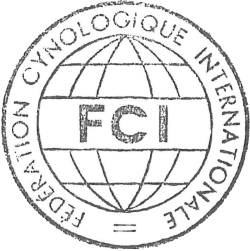Dear Readers,
When you read this Editorial, the Société Royale Saint-Hubert will have organised
the 2016 FCI European Section Show in Brussels.
More than 12,000 participating dogs have entered this prestigious event !!! Isn’t
it amazing? It depends on how you look at those figures! It’s amazing “per se”
as such an entry places the 2016 FCI European Section Show among the top 3 of all
the FCI Section Shows ever. It’s amazing because the World has been going and turning
somewhat wrong lately but still, exhibitors and breeders do want to live their passion
for dogs and keep taking part in all kinds of canine events, be it shows or sport
competitions. We do thank and congratulate them for that.
Read more
Yves De Clercq
FCI Executive Director
FCI Worlwide (1922-2011)
by Y. De Clercq, FCI Executive Director, 1998-...
Part 5/7
At the end of the 1970 General Assembly in Budapest, Ch. Gendebien is not re-elected
as Secretary General after serving the FCI for 19 years.
During his last report, he informs that 121 CACIB shows were held that year and
719 CIB confirmed by the FCI headquarters. The URCSH registered approximately 5,000
kennel names.
A major decision is made: for a pedigree to be recognised by the other FCI members,
it has to be stamped with the newly created FCI stamp. As we know, this situation
will create, at the beginning of the 21st century, big problems which the FCI has
to face as different clubs and organisations make use of a quite similar logo.


1970, design of the FCI logo
Colombia becomes full member and Panama associated member.
Another important decision is made: at CACIB shows, there will now be three classes (Open, Working, Champion), instead of two, where the CACIB will be competed for. In addition, the fee per dog in the catalogue is now 15 BEF (0.375 €). Finally, the FCI members also decide to create a legal commission.
1972 sees the FCI General Assembly travelling outside Europe for the first time. The conference will be organised in Rio de Janeiro (Brazil) under the presidency of Barone Forzano.
In Dortmund, in 1973, after different attempts, all turned down, it is resolved to accept the Spanish language at the General Assemblies and for the post, making it therefore a total of 4 official languages which are still in use nowadays. A Cynological World Congress takes place which focuses on specific scientific items.
The 1974 General Assembly decides that a “World Dog Show” will be conducted on the occasion of the Assembly. The participating figures are particularly impressive and show a steady increase to reach the highest ever entry in 2011 with 21,547 dogs.
List of the World Dog Shows since 1974
| Date |
Place |
Entry |
| 1974 |
Paris |
2 832 |
| 1975 |
Rabbat |
509 |
| 1976 |
Innsbrück |
4 478 |
| 1977 |
Herning |
3 883 |
| 1978 |
Mexico |
|
| 1979 |
Bern |
|
| 1980 |
Verona |
|
| 1981 |
Dortmund |
8 836 |
| 1982 |
Tokyo |
1 404 |
| 1983 |
Madrid |
3 097 |
| 1984 |
Acapulco |
784 |
| 1985 |
Amsterdam |
10 093 |
| 1986 |
Tulln |
7 952 |
| 1987 |
Tel Aviv |
1 274 |
| 1988 |
Lima |
730 |
| 1989 |
Copenhagen |
9 473 |
| 1990 |
Brno |
11 942 |
| 1991 |
Dortmund |
13 427 |
| 1992 |
Valencia |
6 664 |
| 1993 |
Buenos Aires |
2 178 |
| 1994 |
Bern |
15 571 |
| 1995 |
Brussels |
14 164 |
| 1996 |
Vienna/Budapest |
11 833 |
| 1997 |
Porto Rico |
4 060 |
| 1998 |
Helsinki |
15 295 |
| 1999 |
Mexico |
|
| 2000 |
Milan |
15 200 |
| 2001 |
Porto |
7 282 |
| 2002 |
Amsterdam |
14 520 |
| 2003 |
Dortmund |
18 716 |
| 2004 |
Rio de Janeiro |
2 060 |
| 2005 |
Buenos Aires |
2 806 |
| 2006 |
Poznan |
20 869 |
| 2007 |
Mexico |
5 528 |
| 2008 |
Stockholm |
20 661 |
| 2009 |
Bratislava |
21 140 |
| 2010 |
Herning |
18 988 |
| 2011 |
Paris |
21 547 |